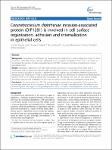Corynebacterium diphtheriae invasion-associated protein (DIP1281) is involved in cell surface organization, adhesion and internalization in epithelial cells
Ott, Lisa
Höller, Martina
Gerlach, Roman
Hensel, Michael
Rheinlaender, Johannes
Schäffer, Tilman E
Burkovski, Andreas
Background: Corynebacterium diphtheriae, the causative agent of diphtheria, is well-investigated in respect to toxin production, while little is known about C. diphtheriae factors crucial for colonization of the host. In this study, we investigated the function of surface-associated protein DIP1281, previously annotated as hypothetical invasion-associated protein. Results: Microscopic inspection of DIP1281 mutant strains revealed an increased size of the single cells in combination with an altered less club-like shape and formation of chains of cells rather than the typical V-like division forms or palisades of growing C. diphtheriae cells. Cell viability was not impaired. Immuno-fluorescence microscopy, SDS-PAGE and 2-D PAGE of surface proteins revealed clear differences of wild-type and mutant protein patterns, which were verified by atomic force microscopy. DIP1281 mutant cells were not only altered in shape and surface structure but completely lack the ability to adhere to host cells and consequently invade these. Conclusions: Our data indicate that DIP1281 is predominantly involved in the organization of the outer surface protein layer rather than in the separation of the peptidoglycan cell wall of dividing bacteria. The adhesion- and invasion-negative phenotype of corresponding mutant strains is an effect of rearrangements of the outer surface.
No license information

